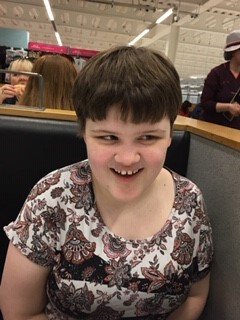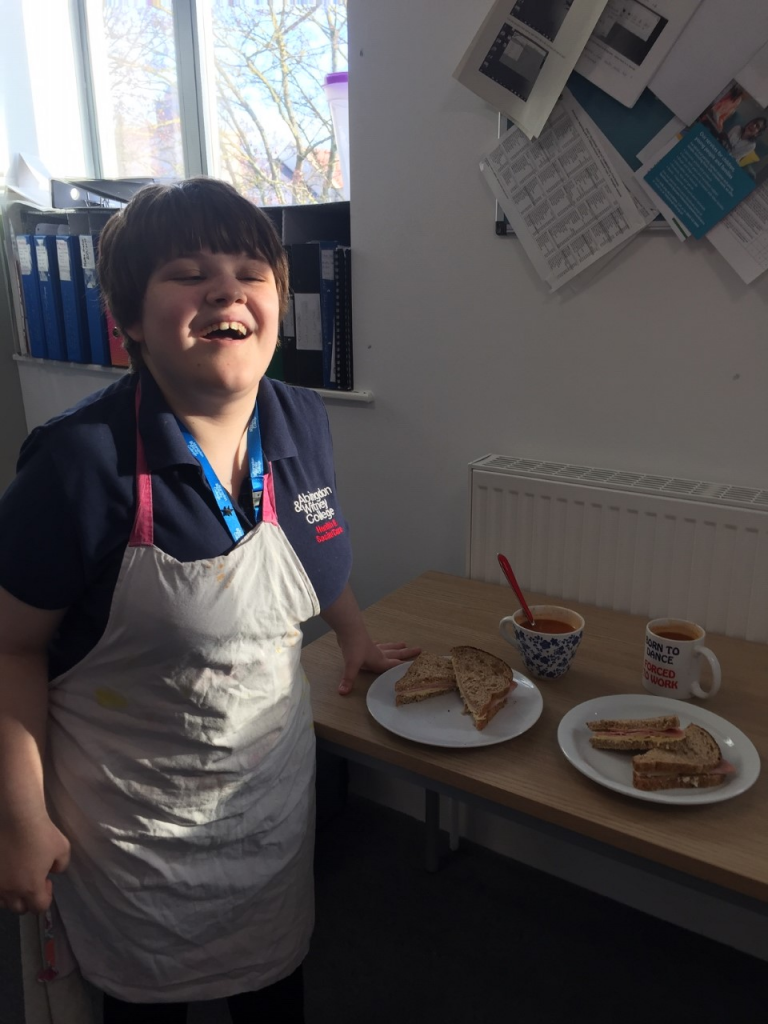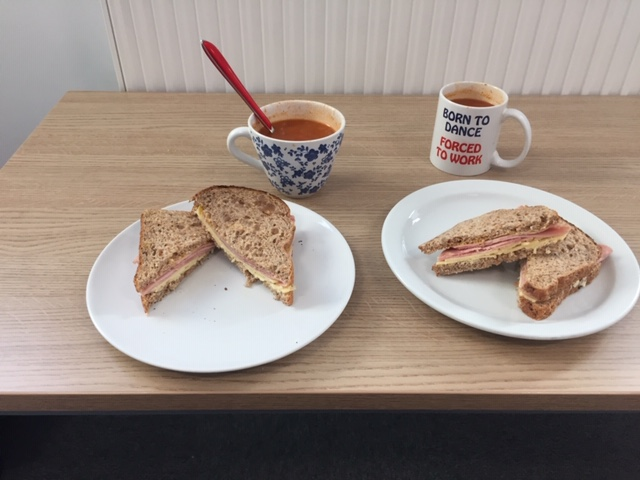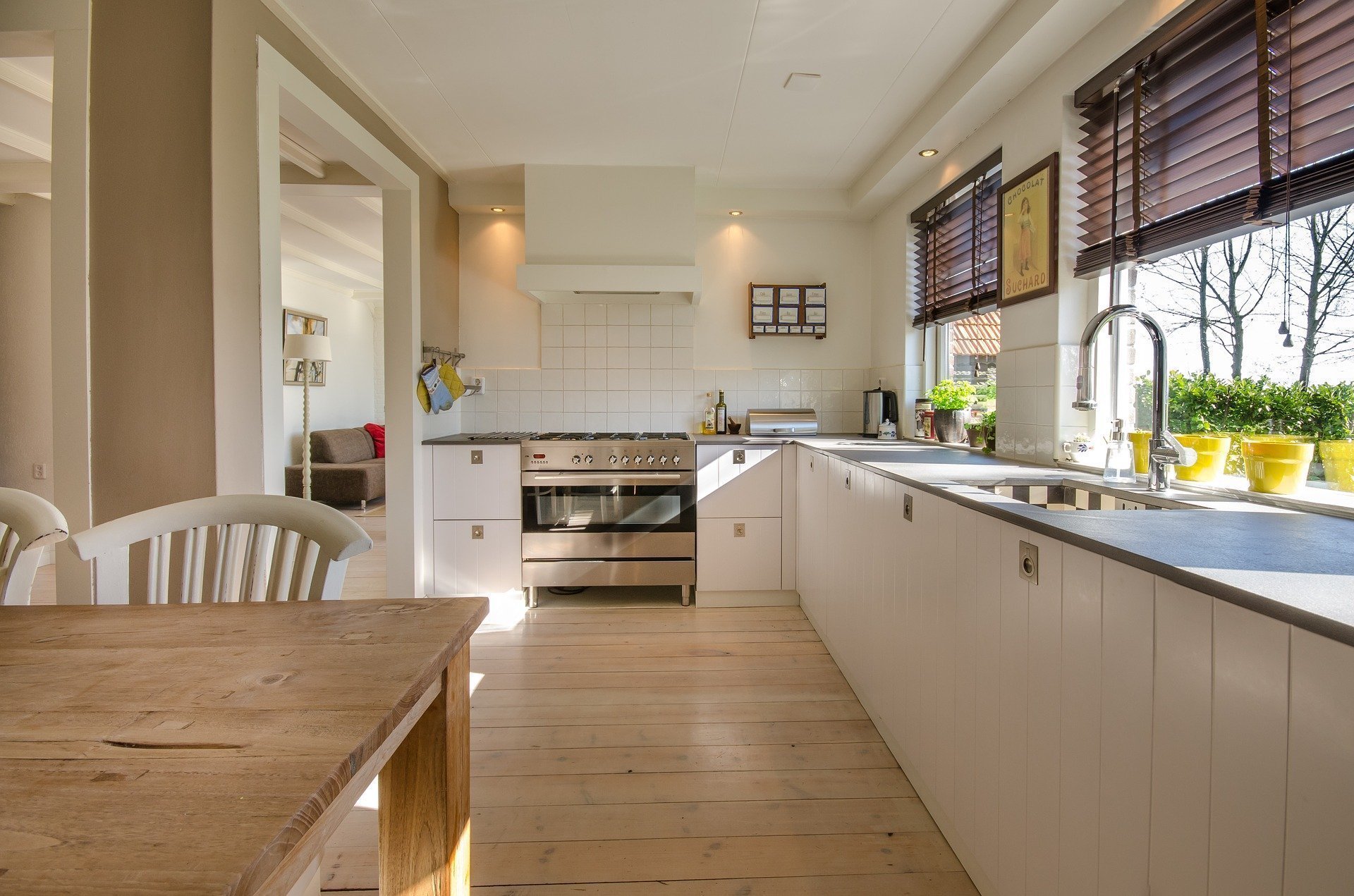By Rona Smith

My name is Rona Smith, I am 19 years-old and I am visually impaired. One of my main goals in life is to be independent. For example: I want to be able to cook some basic meals that are nutritious, but not too fancy. I just want to be able to cook enough to feed myself day-to-day.
There are several things I do in the kitchen to keep myself safe and make life easier. When I wash my hands, I always use soap in a pump as this is easier for me to manage than a bar of soap especially if my hands are already extremely slippery. I do not use my cane to navigate in the kitchen as this could potentially be dangerous so I stand it up by the door. However, the kitchen I use in my College is relatively small and easy to navigate around and I had some practice visits before starting to use it fully. I always use a tray to put ingredients and equipment onto so that I know exactly where they are and it helps to keep everything organized and contained. I also use the same area of work surface each time so that I know my way around. I wear a tabard with poppers instead of an apron as I can’t tie laces or string. I put a tea towel into the pocket of the tabard for easy access when wiping up quickly. When I am in the kitchen, I always grab things by the handles or on the solid side so that I don’t harm myself.

There are many items of specialist equipment I use in the kitchen for safety and to make life easier. I have a pair of large oven gloves that go up to my elbow as I am not confident with heat. I worry about burning myself, but the gloves give me more confidence. I also cook most of my meals using a talking induction hob. Induction hobs are safer to use than standard hobs as only the circles where the pan are get hot. This means that I can control the buttons for temperature and time without the risk of potentially burning myself. All of the buttons on the induction hob are labelled in Braille. I have 2 induction safe pans that I can use with the induction hob. As long as you have an induction safe pan, you should be okay to use an induction hob. I have a battery-operated talking timer that I use for timing meals. The buttons are not labelled in Braille as they are too small, but I am familiar with the positions of them and can usually find the one I want quickly enough. I can also clip it onto my tabard so that I can prepare other ingredients on the go without having to return to where the timer is to check it. This also means that I can hear it better. I use a liquid level indicator for pouring liquids, because this device has 3 metal prongs that fit into the inside rim of a cup. When the cup is full, it beeps so that means that I can stop pouring. I use a Nimble device for cutting open certain types of plastic packaging. A Nimble is a rubber thimble that fits onto one of your fingers and it has a blade at the bottom. You place the blade onto a corner of the packaging you are trying to open and you press down really hard to open it. This only works with certain types of plastic packaging and on paper packaging. I bought a can opener from the Client Resources centre at OAB and I use it for opening tins that don’t have a ring pull. However, I much prefer to use tins that do have a ring pull and I place a spoon in the gap to help me start the ring pull off, because I don’t have much strength in my hands and sometimes, the start end is difficult to find.

When I am cutting up food, I use a kiddy cutter safety knife as I only started learning to use a knife a year ago. This product is serrated to enable me to cut through food easily, but it isn’t sharp enough for me to cut my fingers by accident. When I am reading cooking instructions on packets for example: Uncle Ben’s rice, I use a scanning app on my iPhone along with a giraffe scanning stand. I either use Seeing AI or Envision AI. Most of the time, I use Envision AI as it works better with the College wifi and it can read the bold timing instructions whereas Seeing AI can only read instructions that are in a standard font size which isn’t always helpful, because timing instructions tend to be in bold text. Seeing AI is free to download and free to use, but Envision AI is free to download however, you need to buy either a monthly or yearly subscription to use it. Giraffe scanning stands are easy to assemble once you have practiced a few times. You place the phone in the neck of the stand and you put the packaging or sheet you are trying to read inside the flat bit. I sometimes use electronic talking scales for weighing out ingredients and I use measuring cups and spoons for measuring out specific amounts of liquids. When I am boiling pasta or vegetables, I use a chip pan. I fill the base of the chip pan with cold water. I tip handfuls of pasta or vegetables into the chip basket and boil on the hob. Using a chip pan makes life easier, because the water drains out through the holes of the chip basket.
My 10 top tips for other visually impaired young people who are cooking in the kitchen are:
- Label your spices in Braille so that you know what they are.
- For spreading smooth spreads, you may find it easier to use the back of a desert spoon instead of a knife. This is because sometimes with a knife, you could accidentally spread too hard and break the bread.
- For breaking eggs, bang the egg shell against the edge of a cup, pull the 2 halves apart and depending on how well you cracked it, it should go neatly into the cup.
- When placing a pan on the hob, always make sure that the handle is consistently at one side so you know where it is and don’t burn yourself.
- When boiling pasta, start from cold water, because this is safer and it cooks it quicker.
- Buying pre-grated cheese is easier and safer than grating cheese by hand.
- If you empty pasta into a plastic cereal container with a flip lid, it is then easier to manage and measure out handfuls. It helps to prevent spillages caused by a rip in the packet. Also, consider using Penne pasta or another large pasta shape as these will be easier to grab handfuls from.
- Square-shaped sliced bread is easier than other types of sliced bread, because it allows you to feel the edges more clearly to enable you to spread butter more effectively.
- Use tea towels that feel different or have different patterns on them so that you know what each one is for. For example: a tea towel with square patterns for wiping surfaces and a smooth one for drying up.
- A one-cup kettle is useful in the kitchen when making hot drinks. This type of kettle works like a standard kettle except the lid closes as soon as it is full of water and it is lighter and easier to manage as it only holds enough water for one cup at a time.
I hope you have enjoyed reading this article and I hope that my tips and suggestions are helpful. You don’t need to be able to cook fancy meals, all that matters is if you can make at least 2 different breakfasts, 2 different lunches and several different dinners that are basic, but that are nutritious and will keep you healthy.
Thank you for sharing this Rona. If anyone else wants to share how they do things day to day in our blog, please write to info@oxeyes.org.uk or call 01865 725595.


